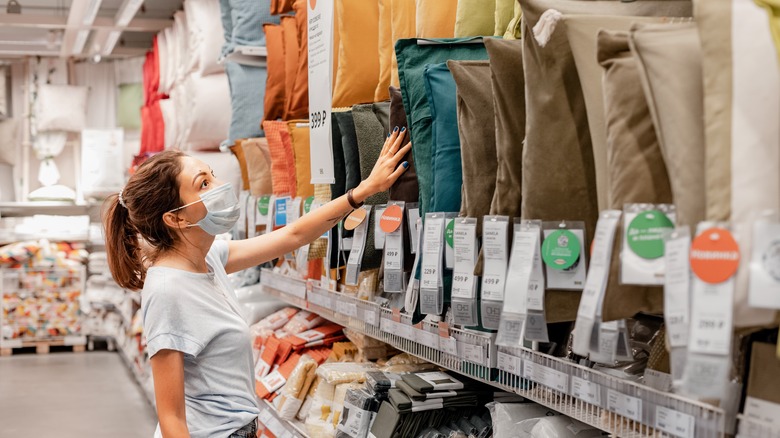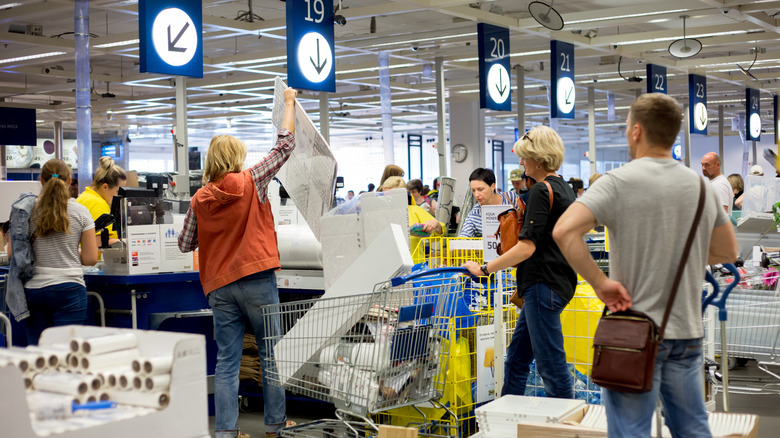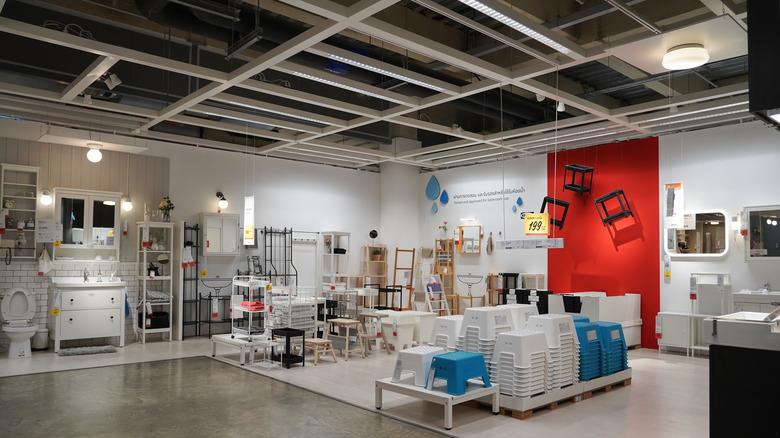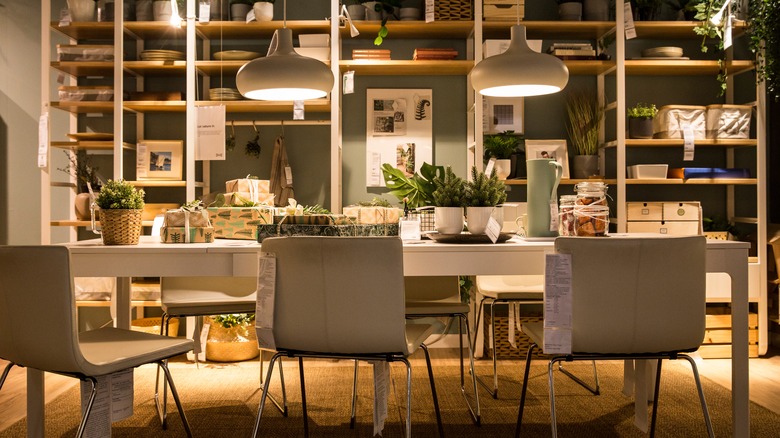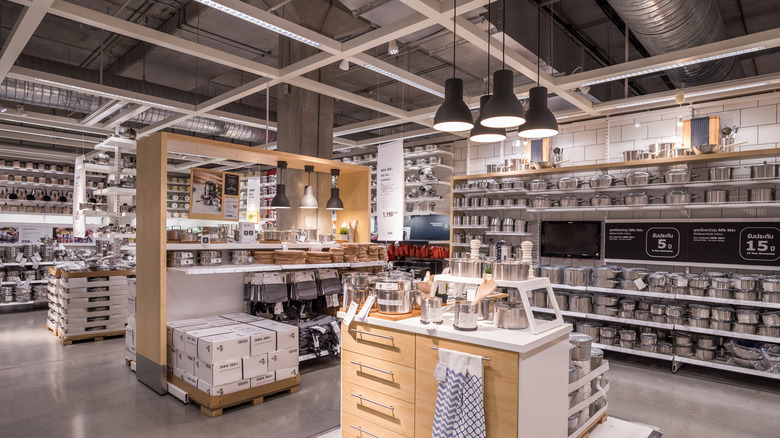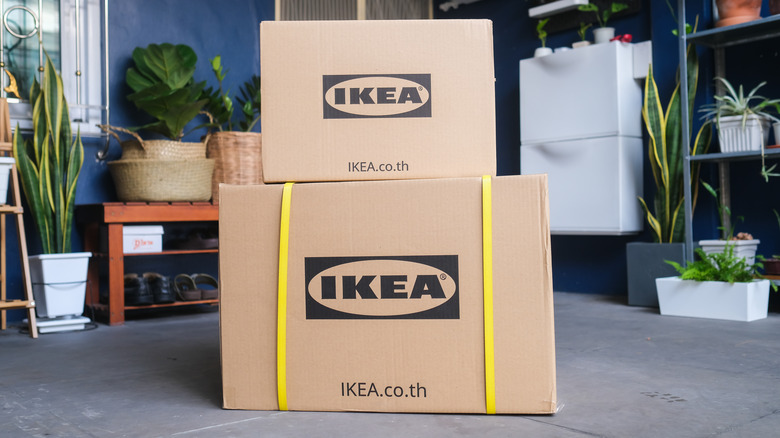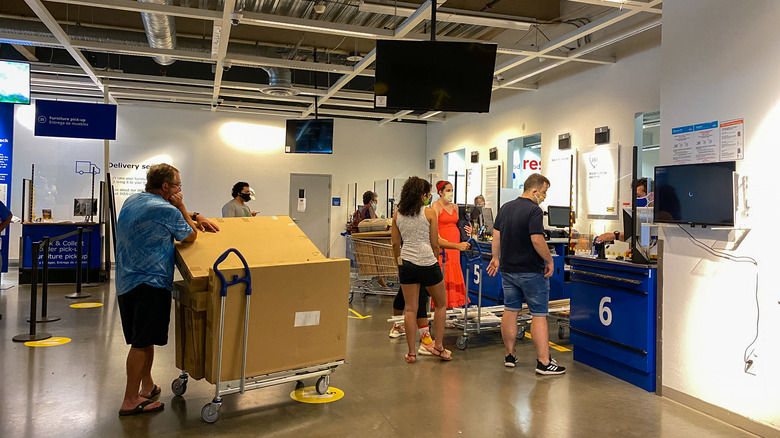The Pros And Cons Of Buying Home Decor From IKEA
Moving into a new space presents a blank canvas of opportunity, with nearly endless options for furniture, paint, décor, and more. However, the price of furnishing and decorating a home can very quickly get out of hand, especially if you're starting from scratch. Even if you just want to revamp or spruce up your space, big-box retailers tend to be unnecessarily expensive.
Still, decorating your home has many benefits. As The Turquoise Home explains, it can help boost your confidence and make any living space feel a lot more cohesive and in line with your own personal goals. Additionally, it's a great chance to let your personality shine and reflect back to you. Plus, there's no need to break the bank to create a beautiful space.
IKEA is known for its low prices and a large catalog of items, ranging from furniture sets to dishes and utensils to home décor. But is the popular furniture retailer's décor all it's cracked up to be? Keep reading for the pros and cons of shopping at IKEA for home offerings.
Pro: it's affordable
One of the main reasons IKEA is so popular is because of its overall affordability. Not only is its furniture a bargain, but its decorative items are also much more inexpensive than competitors, making the Swedish retailer ideal for those looking to decorate their home on a budget.
IKEA's affordable catalog is actually central to its original mission. According to Business Insider, the store's well-known flat packing method — in which items are sold unassembled and customers are responsible for putting everything together — allows for low pricing. That, in combination with its bulk production, keeps items as inexpensive as possible.
While this is intended to keep down furniture costs, it trickles over into the low cost of decorative items. For example, this trendy Anthropologie vase with a handle starts at $48 in the smallest size. A similarly designed vase at IKEA only costs $12 — four times cheaper than its counterpart.
Con: low quality materials and construction
That being said, another reason for IKEA's low prices is the quality of its materials. Now, that doesn't mean all furniture and décor is poorly made. In fact, there are plenty of durable, quality items available, if you know what to look for and what to avoid. Consumers usually have the biggest issues with IKEA particle board furniture, which is then covered in different colored wood veneers. While this is a large part of each product's affordability, it also makes certain products likely to wear, tear, chip, and scratch, per Lighthouse Woodworks.
While this may not always be an issue with IKEA's décor, it still applies. Case in point: Take this Hurring basket. The simple black basket costs $27 and is made of decent quality materials — bamboo, rattan, leather, and steel. It's designed for conveniently and decoratively holding blankets, pillows, and other decorative items. However, it only has a 3.5-star rating, with quite a few customers saying the basket lacks structural integrity. CB2 also sells a black bamboo basket for a much steeper $80. However, it's a lot more structurally sound. This isn't to say all IKEA décor is poorly constructed, but its low prices quite often reflect lower quality products.
Pro: cute and versatile designs
Unlike other popular furniture and décor retailers, IKEA doesn't cater to any specific style or design aesthetic. Instead, it has a very utilitarian but universally applicable look. My First Apartment identifies it as modern and minimalist, but it isn't exclusive to either.
Look at IKEA lighting options, for instance. When it comes to a simple table lamp, the retailer has a large inventory of elevated basic lamps — simple silhouettes with a slight edge or unique design aspect. The Desja lamp is a perfect example of this; the design is quite simple and minimalist, but it has a rather unique, slightly funky silhouette with a rounded, flat top. It would look just as appropriate in an eclectic room as it would in a modern office.
However, there are also options for those wanting to achieve a more specific design. The Åskmuller table lamp is modeled after a vintage kerosene lamp and is perfect for a retro, vintage room, whereas the Simrishamn fixture has a much more modern, sleek design.
Con: it isn't unique
On the flip side, IKEA's mass-produced stock means its décor tends to not be very distinctive. Odds are, you can find a staple IKEA mirror, lamp, rug, or bookcase in almost anyone's abode. If you're striving to have a unique, one-of-a-kind home, IKEA décor likely isn't for you. Its products also tend to have a very specific look, My First Apartment warns. There's nothing wrong with furnishing your home with the basics, but it may not be your personal preference.
However, the retailer does offer some unique decorative items, like the previously mentioned kerosene-inspired table lamp. There are also some cool, traditional Swedish-inspired decorative pieces, like the Finansiell wooden horse. Then again, you may want to avoid some universally popular items, though. These include the Ribba series of picture frames, the Färgrik mug, and the Stockholm and Rens sheepskin rugs, per Business Insider.
Pro: can shop online or in-store
While many people enjoy the convenience of e-commerce sites, IKEA is known for and still attracts countless in-person shoppers. The first half of each store is set up like a maze, guiding you through different showrooms with displays of furniture and décor objects. As you walk along further, you'll eventually wind up in the warehouse, where all the items are housed. This makes shopping there in person somewhat long and perhaps exhausting. However, it also allows you to see products up close and personal in a functional setting.
Conversely, if you didn't want to make a commitment in-person or simply don't want to deal with the labyrinthian furniture store, there's always the option of shopping online. Plus, you have options when it comes to having products delivered to your home or picking them up directly at a nearby location.
The big-box outlet also periodically offers discounts on online and delivery orders (via IKEA). Delivery is also ideal if you plan to purchase lots of items, as IKEA doesn't offer bags at checkout. Whether you prefer shopping traditionally and in-person, from the convenience of your home, or a mix of both, IKEA has you covered with plenty of options.
Con: stringent return policy
While shopping there is made to be incredibly simple, IKEA's return policy is a little more limited in terms of options. However, it's quite generous — you can return unopened items 365 days after purchase and open items within 180 days, per IKEA. All you need is proof of purchase (ideally your receipt) and a government-issued form of identification.
This seems simple enough, except for the fact that IKEA returns have to be done in person. In fact, there's a special entrance for exchanges and returns, and since everything has to be done there, the lines can be a little long. As Rather Be Shopping explains, items bought there cannot be returned via mail or online and instead must be brought back to your local IKEA.
In the case of online purchases and deliveries, you can return items by mail, but your window of opportunity is only two weeks. After 14 days, you can still make a return, but it has to then be done in person. While not the biggest inconvenience in the world, depending on how many products you intend to buy, it can be a bit annoying. Plus, you'll be responsible for driving to and from the store, so make sure to bubble wrap any glass or fragile items.
